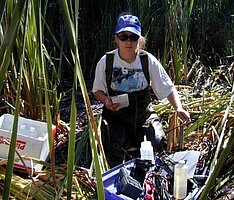Determination of the Factors Causing Elevated Phosphorus Levels in a Natural Wetland and Methods for Remediation

Rochelle Nustad. Rochelle completed her M.S. in Environmental Engineering at North Dakota State University in December 2000. She is employed by the USGS Water Resources Division - North Dakota District, out of its Grand Forks, ND office.
ranustad@usgs.gov
(701) 775-7221
Fellow: Rochelle A. Nustad, Environmental Engineering Program, Department of Civil Engineering, NDSU
Advisor: Wei Lin, Assistant Professor of Civil Engineering, NDSU
Cooperators: Pelican River (MN) Watershed District; Detroit Lakes Water Treatment Plant
Degree Progress: M.S. December 2000
Determination of the Factors Causing Elevated Phosphorus Levels in a Natural Wetland and Methods for Remediation
Thesis Abstract.
Wetlands are known for their capacity to act as sinks or traps for nutrients and are often used for phosphorus and ammonia removal from wastewater streams and agricultural runoff. However, natural peat wetlands near Detroit Lakes, MN, appear to be releasing phosphorus into a drainage ditch.The ditch water running through the wetlands enters Lake Sallie, an important recreational lake. A field study was conducted to determine the factors causing the elevated phosphorus levels in the ditch and a bench scale aeration study was conducted to determine the feasibility of aeration within the ditch as a method to decrease phosphorus at the outlet of the ditch.
Results indicate that biological decomposition of organic matter in the wetland is resulting in the release of phosphate through mineralization. Microbial reactions may also be producing an environment that is favorable for the dissolution of metal-phosphates. These microbial reactions are resulting in high phosphorus concentrations in the wetland pore water. A hydraulic gradient exists in the wetland-complex with water moving from the wetland to the ditch. This gradient results in phosphate being transported from the wetland to the ditch. Results from the bench scale aeration study indicate that aeration is an ineffective method for reducing phosphate concentrations in the ditch. High dissolved oxygen conditions exist most of the year and based upon literature values, it is not possible to reduce phosphate concentrations below present levels.
A copy of the thesis can be obtained from Prof. Wei Lin.



Wei Lin
Civil & Environmental Eng.
Office: Civil/Ind Eng 201D
Telephone: 701-231-6288
Email: wei.lin@ndsu.edu


